- Clone
- B1 (See other available formats)
- Regulatory Status
- RUO
- Other Names
- T cell receptor γ/δ, γ/δ TCR, TCR-γ/δ
- Isotype
- Mouse IgG1, κ
- Ave. Rating
- Submit a Review
- Product Citations
- 8 publications
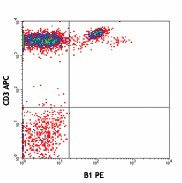
| Cat # | Size | Price | Save |
|---|---|---|---|
| 331209 | 25 tests | ¥26,840 | |
| 331210 | 100 tests | ¥58,960 |
T cell receptor (TCR) is a heterodimer consisting of an α and a β chain (TCR α/β) or a γ and a δ chain (TCR γ/δ). TCR γ/δ is involved in the recognition of certain bacterial, self-CD1 molecule, and tumor antigens bound to MHC class I. The γ/δ TCR associates with CD3 and is expressed on a subset of T cells found in the thymus, the intestinal epithelium, and the peripheral lymphoid tissues and peritoneum. Most γ/δ T cells are CD4-/CD8-, some are CD8+. T cells expressing the γ/δ TCR have been shown to play a role in oral tolerance, innate immune response for some tumor cells, and autoimmune disease. It has been reported that γ/δ T cells also play a principal role in antigen presentation.
Product DetailsProduct Details
- Verified Reactivity
- Human, Cynomolgus, Rhesus
- Reported Reactivity
- African Green, Baboon, Pigtailed Macaque
- Antibody Type
- Monoclonal
- Host Species
- Mouse
- Formulation
- Phosphate-buffered solution, pH 7.2, containing 0.09% sodium azide and BSA (origin USA)
- Preparation
- The antibody was purified by affinity chromatography, and conjugated with PE under optimal conditions.
- Concentration
- Lot-specific (to obtain lot-specific concentration and expiration, please enter the lot number in our Certificate of Analysis online tool.)
- Storage & Handling
- The antibody solution should be stored undiluted between 2°C and 8°C, and protected from prolonged exposure to light. Do not freeze.
- Application
-
FC - Quality tested
SB - Reported in the literature, not verified in house - Recommended Usage
-
Each lot of this antibody is quality control tested by immunofluorescent staining with flow cytometric analysis. For flow cytometric staining, the suggested use of this reagent is 5 µl per million cells in 100 µl staining volume or 5 µl per 100 µl of whole blood.
- Excitation Laser
-
Blue Laser (488 nm)
Green Laser (532 nm)/Yellow-Green Laser (561 nm)
- Application Notes
-
Clone B1 is also known as clone B1.1.
Additional reported applications (for the relevant formats) include: immunohistochemical staining of acetone-fixed frozen sections3 and paraffin-embedded sections5, in vitro blocking, and spatial biology (IBEX)8,9. The Ultra-LEAF™ purified antibody (Endotoxin < 0.01 EU/µg, Azide-Free, 0.2 µm filtered) is recommended for highly sensitive assays (Cat. Nos. 331235 and 331236). - Additional Product Notes
-
Iterative Bleaching Extended multi-pleXity (IBEX) is a fluorescent imaging technique capable of highly-multiplexed spatial analysis. The method relies on cyclical bleaching of panels of fluorescent antibodies in order to image and analyze many markers over multiple cycles of staining, imaging, and, bleaching. It is a community-developed open-access method developed by the Center for Advanced Tissue Imaging (CAT-I) in the National Institute of Allergy and Infectious Diseases (NIAID, NIH).
-
Application References
(PubMed link indicates BioLegend citation) -
- Rodriguez-Gago M, et al. 2001. Transplantation. 72:503.
- Lehmann FS, et al. 2002. Am. J. Physiol. Gastrointest. Liver. Physiol. 283:G481. (FC)
- Bordignon M, et al. 2008. Mol. Med. Rep. 1:485. (IHC)
- Conrad M, et al. 2007. Cytom. Part A 71A:925. (FC)
- Pollinger B, et al. 2011. J. Immunol. 186:2602. (IHC)
- Correia DV, et al. 2011. Blood. 118:992. (Block)
- Laurent AJ, et al. 2014. PLoS One. 9:103683. PubMed
- Radtke AJ, et al. 2020. Proc Natl Acad Sci USA. 117:33455-33465. (SB) PubMed
- Radtke AJ, et al. 2022. Nat Protoc. 17:378-401. (SB) PubMed
- Product Citations
-
- RRID
-
AB_1089219 (BioLegend Cat. No. 331209)
AB_1089218 (BioLegend Cat. No. 331210)
Antigen Details
- Structure
- Ig superfamily, associates with CD3 complex
- Distribution
-
T subset in thymus, intestinal epithelium, peripheral lymphoid tissues and peritoneum
- Function
- Antigen recognition
- Ligand/Receptor
- Some bacterial or tumor antigens bound MHC class I, CD1 molecule
- Cell Type
- Epithelial cells, T cells
- Biology Area
- Adaptive Immunity, Immunology
- Molecular Family
- TCRs
- Antigen References
-
1. Lanier LL, et al. 1987. J. Clin. Immunol. 7:429.
2. Spencer J, et al. 1989. Eur. J. Immunol. 19:1335.
3. Uyemura K, et al. 1991. J. Exp. Med. 174:683.
4. Spada FM, et al. 2000. J. Exp. Med. 191:907. - Gene ID
- 6964 View all products for this Gene ID 6965 View all products for this Gene ID
- UniProt
- View information about TCR gamma/delta on UniProt.org
Related FAQs
- What type of PE do you use in your conjugates?
- We use R-PE in our conjugates.
- If an antibody clone has been previously successfully used in IBEX in one fluorescent format, will other antibody formats work as well?
-
It’s likely that other fluorophore conjugates to the same antibody clone will also be compatible with IBEX using the same sample fixation procedure. Ultimately a directly conjugated antibody’s utility in fluorescent imaging and IBEX may be specific to the sample and microscope being used in the experiment. Some antibody clone conjugates may perform better than others due to performance differences in non-specific binding, fluorophore brightness, and other biochemical properties unique to that conjugate.
- Will antibodies my lab is already using for fluorescent or chromogenic IHC work in IBEX?
-
Fundamentally, IBEX as a technique that works much in the same way as single antibody panels or single marker IF/IHC. If you’re already successfully using an antibody clone on a sample of interest, it is likely that clone will have utility in IBEX. It is expected some optimization and testing of different antibody fluorophore conjugates will be required to find a suitable format; however, legacy microscopy techniques like chromogenic IHC on fixed or frozen tissue is an excellent place to start looking for useful antibodies.
- Are other fluorophores compatible with IBEX?
-
Over 18 fluorescent formats have been screened for use in IBEX, however, it is likely that other fluorophores are able to be rapidly bleached in IBEX. If a fluorophore format is already suitable for your imaging platform it can be tested for compatibility in IBEX.
- The same antibody works in one tissue type but not another. What is happening?
-
Differences in tissue properties may impact both the ability of an antibody to bind its target specifically and impact the ability of a specific fluorophore conjugate to overcome the background fluorescent signal in a given tissue. Secondary stains, as well as testing multiple fluorescent conjugates of the same clone, may help to troubleshoot challenging targets or tissues. Using a reference control tissue may also give confidence in the specificity of your staining.
- How can I be sure the staining I’m seeing in my tissue is real?
-
In general, best practices for validating an antibody in traditional chromogenic or fluorescent IHC are applicable to IBEX. Please reference the Nature Methods review on antibody based multiplexed imaging for resources on validating antibodies for IBEX.
Other Formats
View All TCR γ/δ Reagents Request Custom Conjugation| Description | Clone | Applications |
|---|---|---|
| Purified anti-human TCR γ/δ | B1 | FC,IHC |
| Biotin anti-human TCR γ/δ | B1 | FC,IHC |
| FITC anti-human TCR γ/δ | B1 | FC |
| PE anti-human TCR γ/δ | B1 | FC,SB |
| APC anti-human TCR γ/δ | B1 | FC |
| Alexa Fluor® 647 anti-human TCR γ/δ | B1 | FC |
| Brilliant Violet 421™ anti-human TCR γ/δ | B1 | FC |
| Brilliant Violet 510™ anti-human TCR γ/δ | B1 | FC |
| PE/Cyanine7 anti-human TCR γ/δ | B1 | FC |
| PerCP/Cyanine5.5 anti-human TCR γ/δ | B1 | FC |
| PE/Dazzle™ 594 anti-human TCR γ/δ | B1 | FC |
| APC/Fire™ 750 anti-human TCR γ/δ | B1 | FC |
| TotalSeq™-A0139 anti-human TCR γ/δ | B1 | PG |
| TotalSeq™-C0139 anti-human TCR γ/δ | B1 | PG |
| TotalSeq™-B0139 anti-human TCR γ/δ | B1 | PG |
| Ultra-LEAF™ Purified anti-human TCR γ/δ | B1 | FC,FA,IHC,Block |
| PE/Fire™ 700 anti-human TCR γ/δ Antibody | B1 | FC |
| Alexa Fluor® 660 anti-human TCR γ/δ Antibody | B1 | FC |
| TotalSeq™-D0139 anti-human TCR γ/δ | B1 | PG |
| PE/Fire™ 810 anti-human TCR γ/δ | B1 | FC |
| Brilliant Violet 650™ anti-human TCR γ/δ | B1 | FC |
| Brilliant Violet 785™ anti-human TCR γ/δ | B1 | FC |
Customers Also Purchased
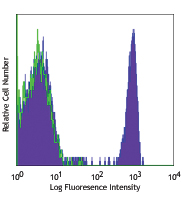
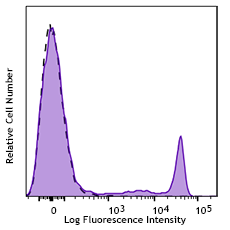
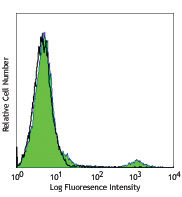
Compare Data Across All Formats
This data display is provided for general comparisons between formats.
Your actual data may vary due to variations in samples, target cells, instruments and their settings, staining conditions, and other factors.
If you need assistance with selecting the best format contact our expert technical support team.
-
Purified anti-human TCR γ/δ
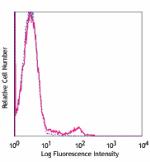
Human peripheral blood lymphocytes stained with purified B1,... -
Biotin anti-human TCR γ/δ
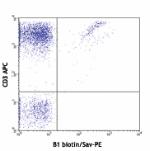
Human peripheral blood lymphocytes stained with CD3 APC and ... -
FITC anti-human TCR γ/δ
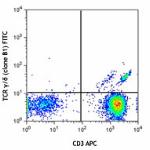
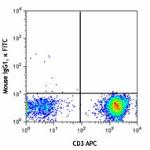
-
PE anti-human TCR γ/δ
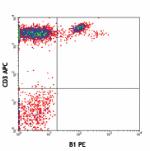
Human peripheral blood lymphocytes stained with CD3 (UCHT1) ... 
Confocal image of C57BL/6 mouse thymus sample acquired using... -
APC anti-human TCR γ/δ

Human peripheral blood lymphocytes stained with CD3 PE and B... -
Alexa Fluor® 647 anti-human TCR γ/δ

Human peripheral blood lymphocytes stained with CD3 PE and B... -
Brilliant Violet 421™ anti-human TCR γ/δ
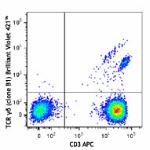
Human peripheral blood lymphocytes were stained with CD3 APC... 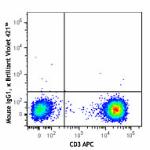
-
Brilliant Violet 510™ anti-human TCR γ/δ
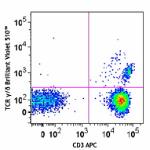
Human peripheral blood lymphocytes were stained with CD3 APC... 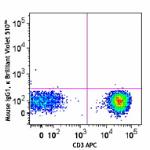
-
PE/Cyanine7 anti-human TCR γ/δ

Human peripheral blood lymphocytes were stained with CD3 FIT... -
PerCP/Cyanine5.5 anti-human TCR γ/δ

Human peripheral blood lymphocytes were stained with CD3 APC... -
PE/Dazzle™ 594 anti-human TCR γ/δ
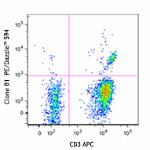
Human peripheral blood lymphocytes were stained with CD3 APC... 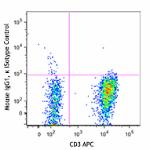
-
APC/Fire™ 750 anti-human TCR γ/δ
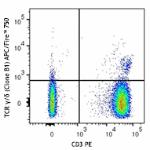
Human peripheral blood lymphocytes were stained with CD3 PE ... 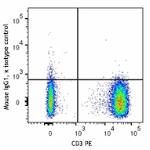
-
TotalSeq™-A0139 anti-human TCR γ/δ
-
TotalSeq™-C0139 anti-human TCR γ/δ
-
TotalSeq™-B0139 anti-human TCR γ/δ
-
Ultra-LEAF™ Purified anti-human TCR γ/δ

Human peripheral blood lymphocytes stained with purified B1,... -
PE/Fire™ 700 anti-human TCR γ/δ Antibody

Human peripheral blood lymphocytes were stained with anti-hu... -
Alexa Fluor® 660 anti-human TCR γ/δ Antibody

Human peripheral blood lymphocytes were stained with CD3 FIT... -
TotalSeq™-D0139 anti-human TCR γ/δ
-
PE/Fire™ 810 anti-human TCR γ/δ

Human peripheral blood lymphocytes were stained with anti-hu... -
Brilliant Violet 650™ anti-human TCR γ/δ

Human peripheral blood lymphocytes were stained with anti-hu... -
Brilliant Violet 785™ anti-human TCR γ/δ

Human peripheral blood lymphocytes were stained with anti-hu...












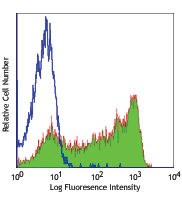






Follow Us